Abstract
Group-specific component (Gc) proteins are human plasma proteins for which a worldwide polymorphism exists. As yet no functional role has been assigned this protein. We show that the products of both Gc alleles, proteins Gc 1 and Gc 2 (distinguished electrophoretically), bind substantial quantities of vitamin D and 25-hydroxyvitamin D. Three lines of evidence are reported: (1) Polyacrylamide gel electrophoresis and autoradiography of serum labeled with (14-C)vitamin D3 revealed patterns of radioactive bands identical to those expected of the two Gc alleles. Population gene frequencies for these proteins binding vitamin D were in the range of those reported for Gc, and individuals of known Gc phenotype were found to have the corresponding vitamin-D-binding phenotype. (2) Immunoelectrophoresis and autoradiography of labeled serum reacted against antiserum to human Gc revealed labeling by (14-C)vitamin D3 of Gc-antibody precipitation ares. (3) (14-C)vitamin D3 or 25-hydroxy(3-H)vitamin D3 was found to coprecipitate specifically with Gc in serum incubated with Gc antiserum. Use of these techniques demonstrated further that plasma proteins that bind vitamin D and that are immunologically similar to human Gc are found in mouse, rat, cow, horse, dog, rhesus monkey, and chimpanzee. We propose that Gc and "vitamin-D-binding alpha-globulin" are in fact the same portein, and that the ability of Gc to bind vitamin D may be directly related to the action of selection on this locus. These techniques may also find application in the study of other plasms transport proteins.
Full text
PDF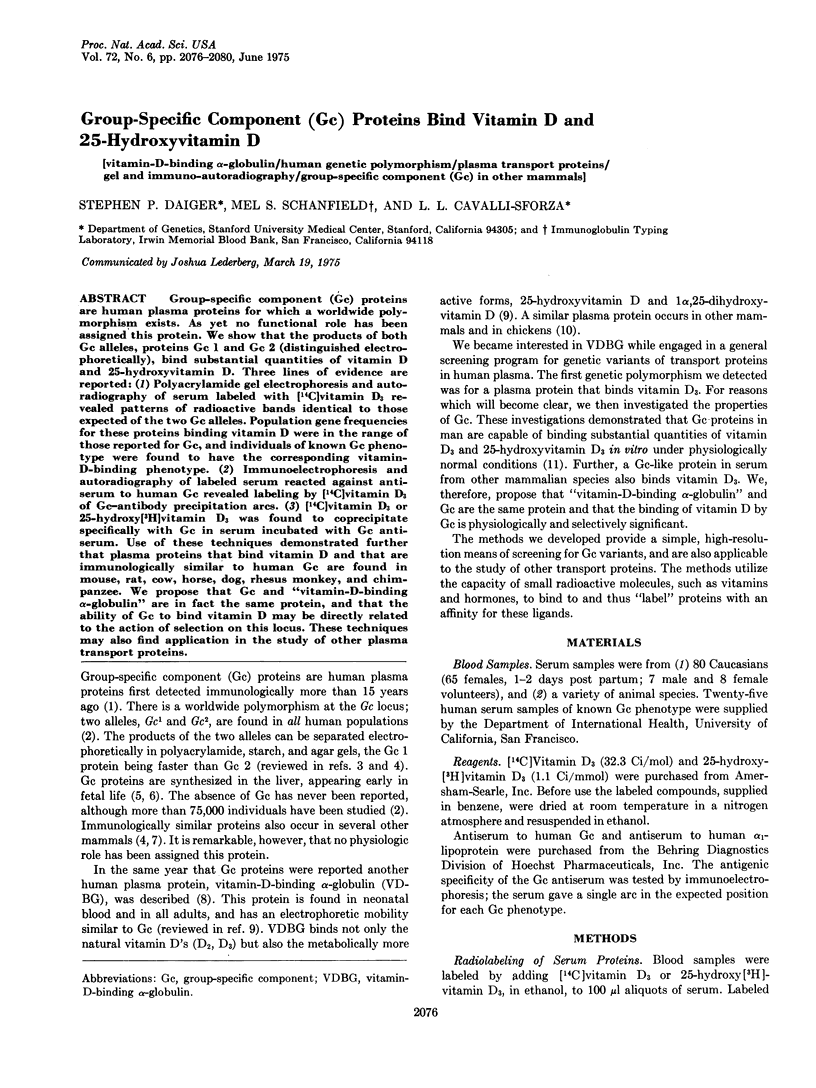
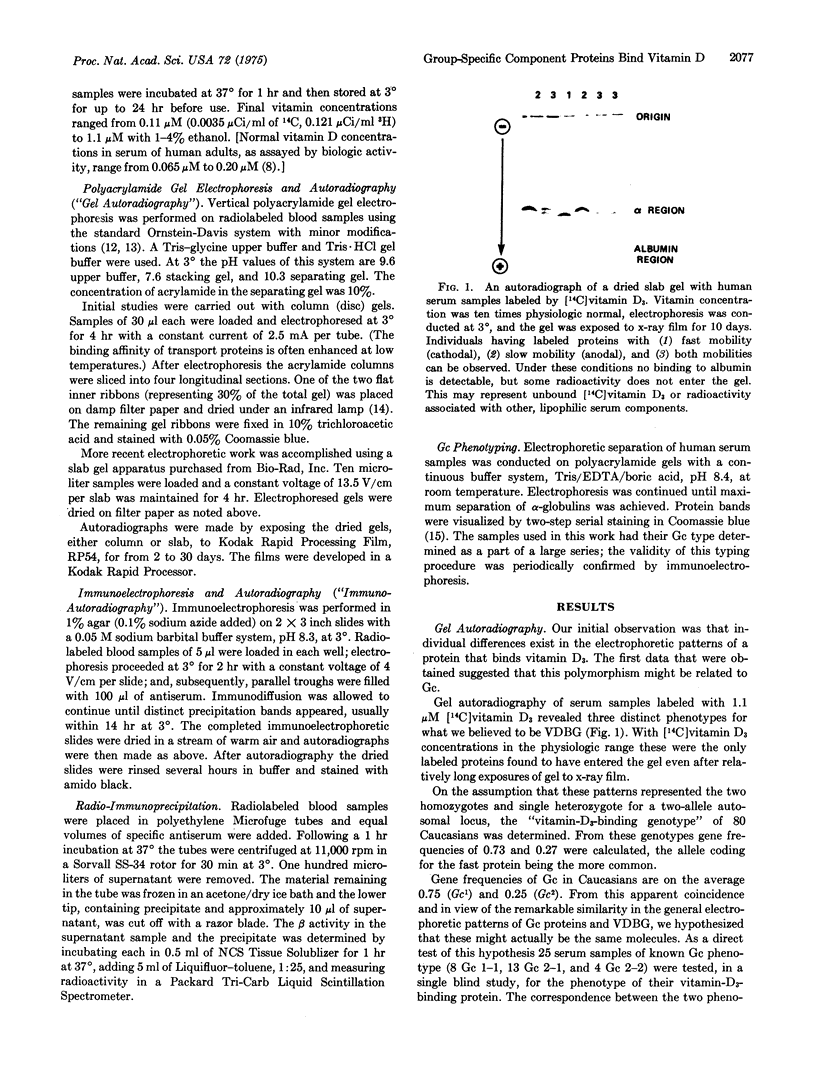
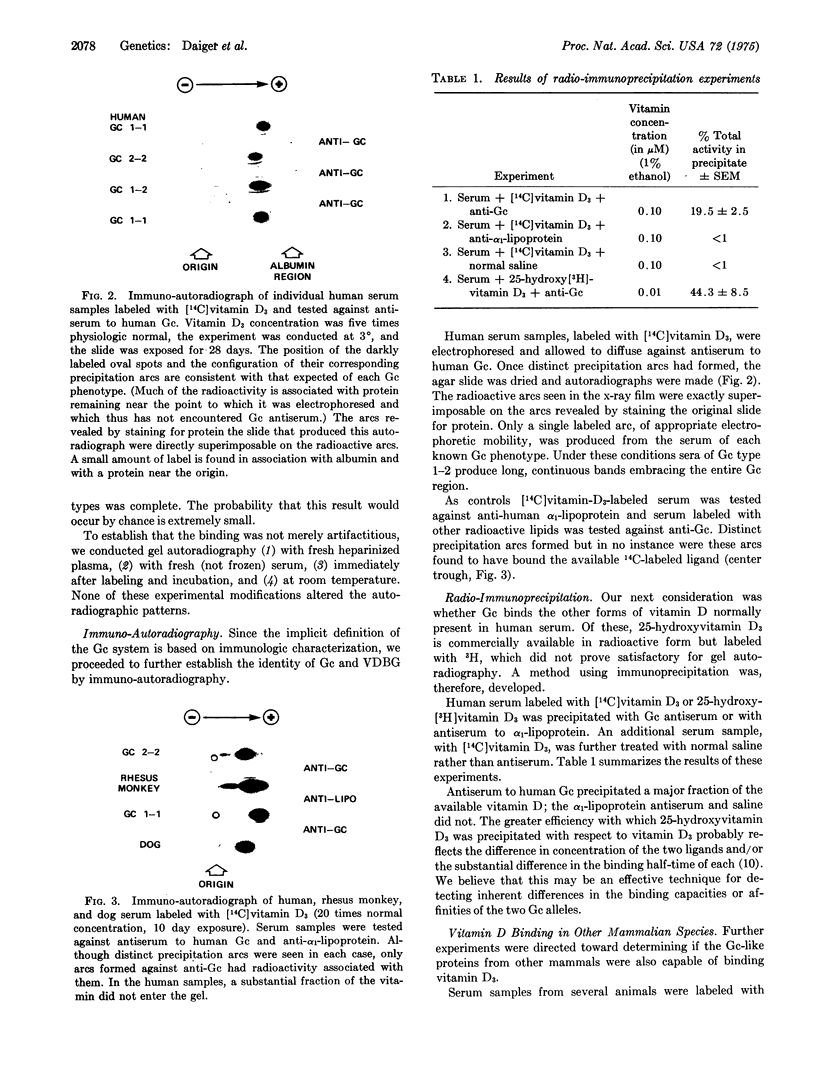
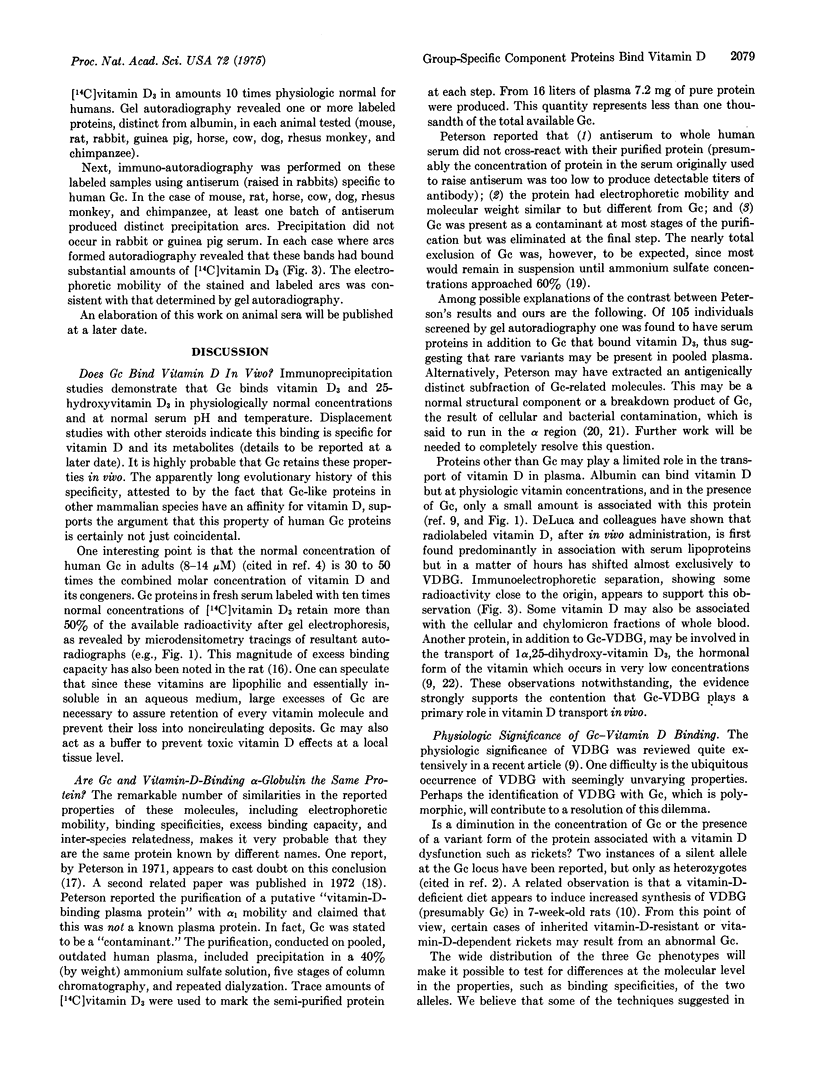
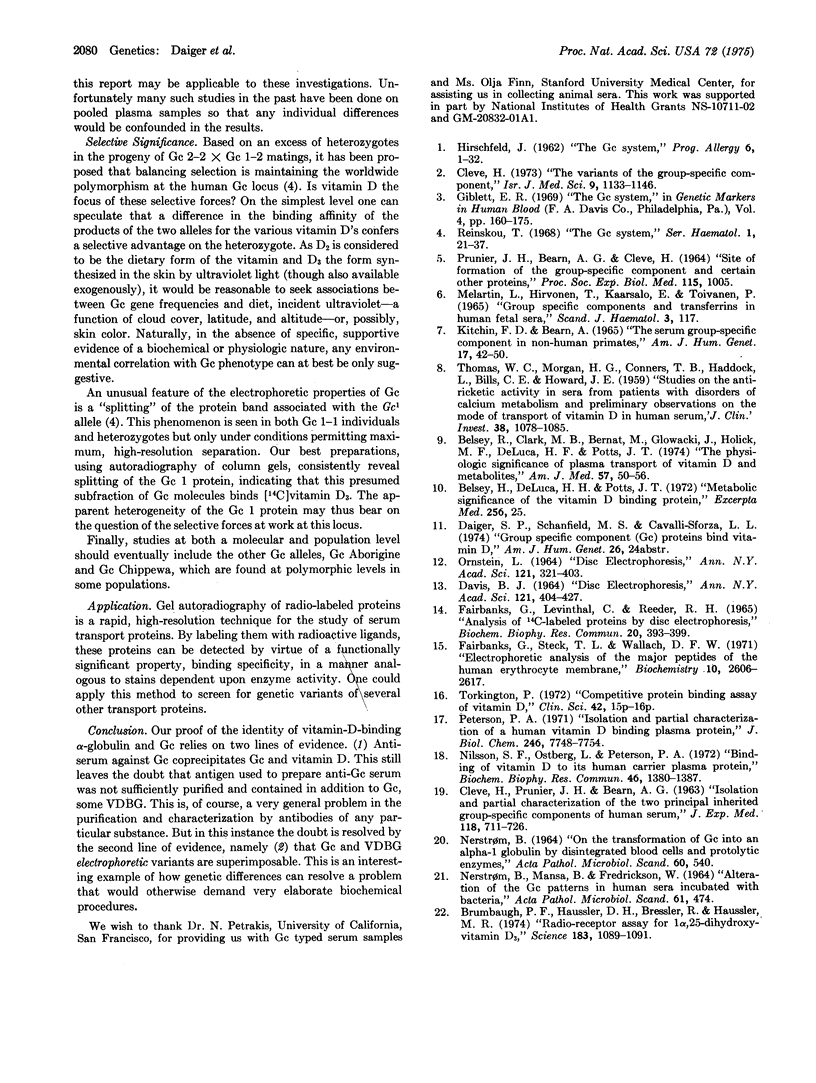
Images in this article
Selected References
These references are in PubMed. This may not be the complete list of references from this article.
- Belsey R., Clark M. B., Bernat M., Glowacki J., Holick M. F., DeLuca H. F., Potts J. T., Jr The physiologic significance of plasma transport of vitamin D and metabolites. Am J Med. 1974 Jul;57(1):50–56. doi: 10.1016/0002-9343(74)90767-0. [DOI] [PubMed] [Google Scholar]
- Brumbaugh P. F., Haussler D. H., Bressler R., Haussler M. R. Radioreceptor assay for 1 alpha,25-dihydroxyvitamin D3. Science. 1974 Mar 15;183(4129):1089–1091. doi: 10.1126/science.183.4129.1089. [DOI] [PubMed] [Google Scholar]
- CLEVE H., PRUNIER J. H., BEARN A. G. ISOLATION AND PARTIAL CHARACTERIZATION OF THE TWO PRINCIPAL INHERITED GROUP-SPECIFIC COMPONENTS OF HUMAN SERUM. J Exp Med. 1963 Nov 1;118:711–726. doi: 10.1084/jem.118.5.711. [DOI] [PMC free article] [PubMed] [Google Scholar]
- Cleve H. The variants of the group-specific component. A review of their distribution in human populations. Isr J Med Sci. 1973 Sep-Oct;9(9):1133–1146. [PubMed] [Google Scholar]
- DAVIS B. J. DISC ELECTROPHORESIS. II. METHOD AND APPLICATION TO HUMAN SERUM PROTEINS. Ann N Y Acad Sci. 1964 Dec 28;121:404–427. doi: 10.1111/j.1749-6632.1964.tb14213.x. [DOI] [PubMed] [Google Scholar]
- Fairbanks G., Jr, Levinthal C., Reeder R. H. Analysis of C14-labeled proteins by disc electrophoresis. Biochem Biophys Res Commun. 1965 Aug 16;20(4):393–399. doi: 10.1016/0006-291x(65)90589-9. [DOI] [PubMed] [Google Scholar]
- Fairbanks G., Steck T. L., Wallach D. F. Electrophoretic analysis of the major polypeptides of the human erythrocyte membrane. Biochemistry. 1971 Jun 22;10(13):2606–2617. doi: 10.1021/bi00789a030. [DOI] [PubMed] [Google Scholar]
- KALLOS P., WAKSMAN B. H. Progress in allergy. Introduction. Prog Allergy. 1962;6:1–29. [PubMed] [Google Scholar]
- KITCHIN F. D., BEARN A. G. THE SERUM GROUP SPECIFIC COMPONENT IN NONHUMAN PRIMATES. Am J Hum Genet. 1965 Jan;17:42–50. [PMC free article] [PubMed] [Google Scholar]
- Melartin L., Hirvonen T., Kaarsalo E., Toivanen P. Group-specific components and transferrins in human fetal sera. Scand J Haematol. 1966;3(2):117–122. doi: 10.1111/j.1600-0609.1966.tb01432.x. [DOI] [PubMed] [Google Scholar]
- NERSTROM B., MANSA B., FREDERIKSEN W. ALTERATION OF THE GC PATTERNS IN HUMAN SERA INCUBATED WITH BACTERIA. Acta Pathol Microbiol Scand. 1964;61:474–482. doi: 10.1111/apm.1964.61.3.474. [DOI] [PubMed] [Google Scholar]
- NERSTROM B. ON THE TRANSFORMATION OF GC INTO AN ALPHA-1 GLOBULIN BY DISINTEGRATED BLOOD CELLS AND PROTEOLYTIC ENZYMES. Acta Pathol Microbiol Scand. 1964;60:540–548. doi: 10.1111/apm.1964.60.4.540. [DOI] [PubMed] [Google Scholar]
- Nilsson S. F., Ostberg L., Peterson P. A. Binding of vitamin D to its human carrier plasma protein. Biochem Biophys Res Commun. 1972 Feb 16;46(3):1380–1387. doi: 10.1016/s0006-291x(72)80128-1. [DOI] [PubMed] [Google Scholar]
- ORNSTEIN L. DISC ELECTROPHORESIS. I. BACKGROUND AND THEORY. Ann N Y Acad Sci. 1964 Dec 28;121:321–349. doi: 10.1111/j.1749-6632.1964.tb14207.x. [DOI] [PubMed] [Google Scholar]
- PRUNIER J. H., BEARN A. G., CLEVE H. SITE OF FORMATION OF THE GROUP-SPECIFIC COMPONENT AND CERTAIN OTHER SERUM PROTEINS. Proc Soc Exp Biol Med. 1964 Apr;115:1005–1007. doi: 10.3181/00379727-115-29101. [DOI] [PubMed] [Google Scholar]
- Peterson P. A. Isolation and partial characterization of a human vitamin D-binding plasma protein. J Biol Chem. 1971 Dec 25;246(24):7748–7754. [PubMed] [Google Scholar]
- THOMAS W. C., Jr, MORGAN H. G., CONNOR T. B., HADDOCK L., BILLS C. E., HOWARD J. E. Studies of antiricketic activity in sera from patients with disorders of calcium metabolism and preliminary observations on the mode of transport of vitamin D in human serum. J Clin Invest. 1959 Jul;38(7):1078–1085. doi: 10.1172/JCI103884. [DOI] [PMC free article] [PubMed] [Google Scholar]
- Torkington P. Competitive protein binding assay of vitamin D. Clin Sci. 1972 Apr;42(4):15P–16P. doi: 10.1042/cs042015pa. [DOI] [PubMed] [Google Scholar]





